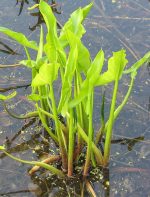 Also called green arrow arum and tuckahoe, this aquatic plant is a member of the arum family, Aracaeae, that also includes Jack in the pulpit, peace lily, and skunk cabbage. It is native to Eastern and southeastern US where it is found growing in swamps and marshes as well as along muddy shorelines of streams and lakes in both bright light and deep shade. Plants tend to grow in clumps from rhizomes and have arrowhead-shaped medium green leaves up to twelve inches long on long petioles. Tiny greenish-white to greenish yellow flowers appear in spring on a finger-like spadix three to six inches long with male flowers on top, female flowers on the bottom, and sterile flowers in between. Each spadix is surrounded by a yellowish green, leaf-like spathe up to eight inches long and slightly spreading. Arrow arum is a good choice for a water garden. It was used by native Americans for food after prolonged cooking to degrade the calcium oxalate crystals contained in the plant and are a large constituent of kidney stones. The generic name Peltandra comes from the Greek words pelta meaning shield, and andros meaning man. The specific epithet, virginica, refers to the geographic area where the plant is found.
Also called green arrow arum and tuckahoe, this aquatic plant is a member of the arum family, Aracaeae, that also includes Jack in the pulpit, peace lily, and skunk cabbage. It is native to Eastern and southeastern US where it is found growing in swamps and marshes as well as along muddy shorelines of streams and lakes in both bright light and deep shade. Plants tend to grow in clumps from rhizomes and have arrowhead-shaped medium green leaves up to twelve inches long on long petioles. Tiny greenish-white to greenish yellow flowers appear in spring on a finger-like spadix three to six inches long with male flowers on top, female flowers on the bottom, and sterile flowers in between. Each spadix is surrounded by a yellowish green, leaf-like spathe up to eight inches long and slightly spreading. Arrow arum is a good choice for a water garden. It was used by native Americans for food after prolonged cooking to degrade the calcium oxalate crystals contained in the plant and are a large constituent of kidney stones. The generic name Peltandra comes from the Greek words pelta meaning shield, and andros meaning man. The specific epithet, virginica, refers to the geographic area where the plant is found.
Type: Aquatic herbaceous perennial
Bloom: Tiny greenish-white to greenish yellow flowers on a finger-like spadix three to six inches long with male flowers on top, female flowers on the bottom, and sterile flowers in between surrounded by a yellowish green, leaf-like spathe up to eight inches long and slightly spreading; spring
Size: 18-24” H x 19-24” W
Light: Bright light to full shade
Soil: Wet
Hardiness: Zones 5-9
Care: Low maintenance
Pests and Diseases: None of significance
Propagation: Seed, division
Companion Plants: Cardinal flowers (Lobelia cardinalis), blue lobelia (Lobelia vedrariensis), obedient plant (Physostegia virginiana)